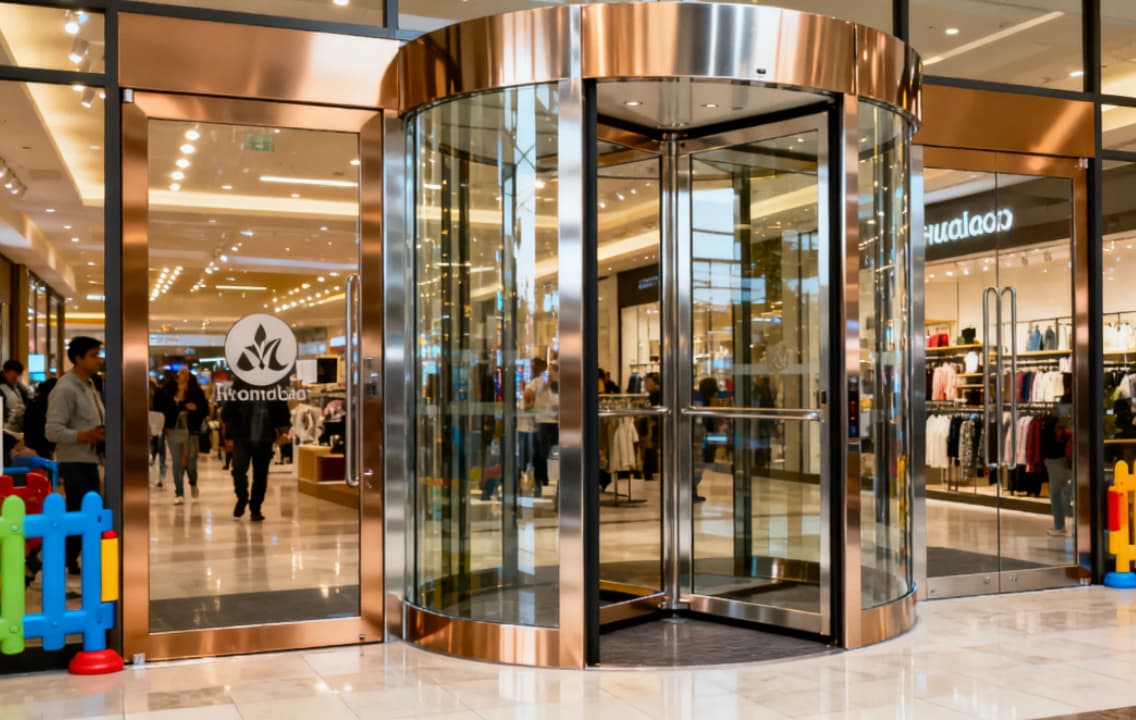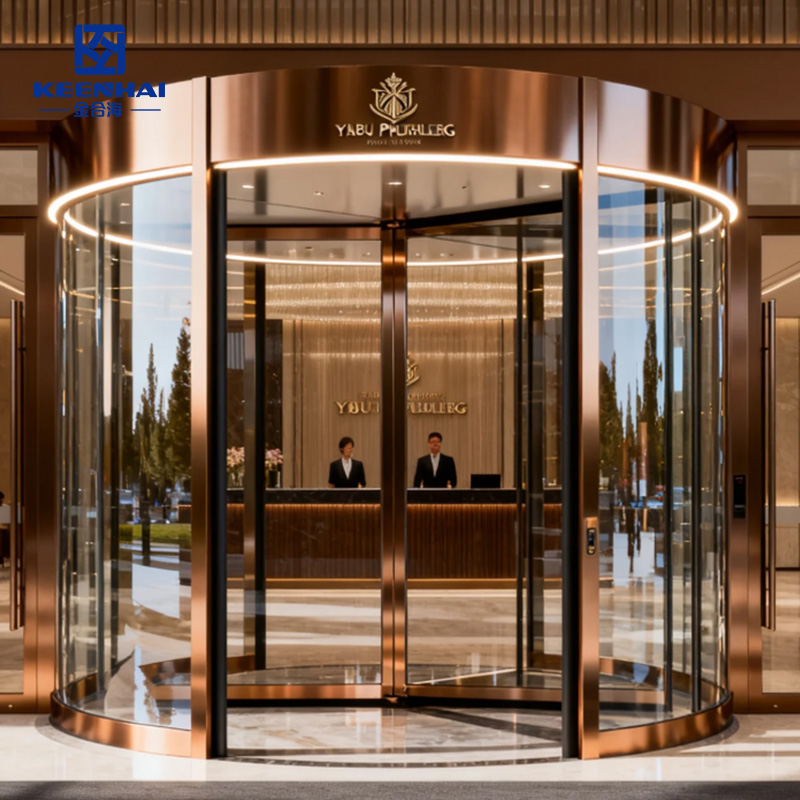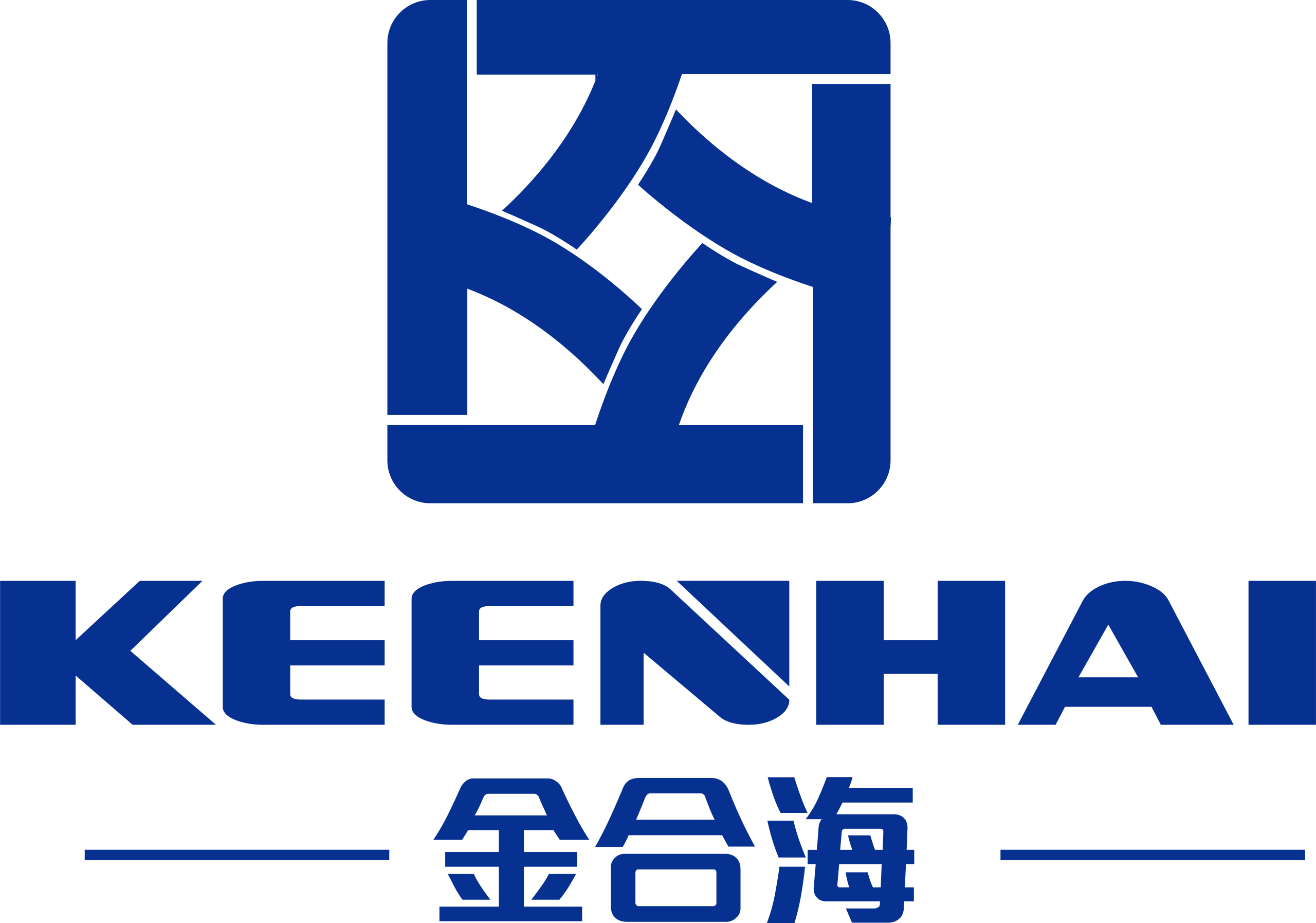The price of a stainless steel glass revolving door in 2025 varies from $6,000 to $20,000, depending on its size, glass type, and automation level. Premium PVD-coated models for luxury hotels and malls usually sit at the higher end, offering unmatched corrosion resistance and design flexibility for high-traffic environments.
1. Main Factors Influencing Stainless Steel Glass Revolving Door Prices
The cost of a stainless steel glass revolving door varies widely depending on the project scale, architectural design, and finish requirements. In 2025, most commercial-grade revolving systems fall between $6,000 and $25,000, but that range can shift dramatically once custom fabrication, automation, or decorative finishes come into play. Below are the four major factors that determine total pricing.
1.1 Door Size and Configuration
The overall diameter and height of the revolving door are the first cost drivers. A small 2.4–2.8m manual door used for offices typically costs $6,000–$9,000, dok je 3.2–3.6m automatic four-wing model designed for large hotel lobbies can easily exceed $18,000–$25,000.
Larger doors require stronger frames, thicker tempered glass, and heavier pivot systems to ensure smooth rotation and stability. Multi-wing configurations also increase mechanical complexity, which raises installation and maintenance expenses.
1.2 Material Grade and Finish Options
Material grade plays a huge role in pricing and long-term performance. Standard models use SUS 304 stainless steel, which provides good corrosion resistance for most indoor and semi-outdoor spaces. However, SUS 316 ili marine-grade stainless steel—often specified for coastal or high-humidity environments—adds roughly 15–20% do ukupnih troškova.
Aesthetics also matter: sjajno polirano ili hairline finishes are common for modern retail buildings, while gold PVD stainless finishes used in luxury hotels can raise prices by 25–35% but deliver a timeless, high-end appearance.
1.3 Glass Type and Thickness
Glass accounts for nearly one-third of total cost. Most standard revolving systems use 10mm tempered glass, but upgrading to 12mm low-iron ili laminated safety glass increases durability and impact resistance.
For example, laminated glass is often chosen for shopping malls or airports where wind load and traffic flow are heavier. Although the price difference is around 10–20%, this upgrade reduces vibration, improves sound insulation, and extends service life.
1.4 Custom Design and Brand Factors
Custom branding, integrated lighting, and automation options add clear value but also significant cost. A door with etched company logos, RGB perimeter lighting, ili touchless motion sensors can cost 10–25% more than a standard configuration.
High-end architectural projects—such as five-star hotels ili corporate headquarters—tend to specify bespoke finishes, seamless glass joints, and precision-balanced wings, all of which demand additional fabrication time and higher-grade hardware.
| Pricing Factor | Standard Range / Upgrade Impact | Notes & Real Application |
|---|---|---|
| Door Size & Type | 2.4–2.8m manual → $6k–$9k 3.0–3.6m automatic → $10k–$25k |
Larger sizes and more wings mean heavier hardware and reinforced shafts. |
| Material & Finish | 304 SS → base 316 SS → +15–20% Gold PVD → +25–35% |
Gold or mirror finishes dominate luxury hotel entrances. |
| Glass Specification | 10mm tempered → base 12mm laminated → +10–20% |
Preferred in shopping malls ili airports for higher durability. |
| Customization & Branding | Basic brushed → base Logo, lighting, sensors → +10–25% |
Common in corporate lobbies i high-end retail projects. |
To put it simply, the more unique the structure and finish, the more you’ll pay—but also the longer it will last and the more prestige it brings to your building’s entrance.

2. Average Price Range in 2025
The cost of a Rotirajuća staklena vrata od nehrđajućeg čelika varies widely based on configuration, automation, and finish. Below you’ll find realistic price bands for typical models in 2025 and what drives those numbers—size, motorization, glass spec, and installation complexity all matter.
| Model Category | Typical Price Range (USD) | Key Cost Drivers | Tipična upotreba |
|---|---|---|---|
| Standard Manual Revolving Door | $5,000 – $12,000 | Diameter, basic hardware, 8–10mm tempered glass | Small offices, boutique retail |
| Automatic Revolving Door System | $10,000 – $28,000 | Motor & drive, sensors, heavier structure, electrical work | Malls, airports, busy lobbies |
| Premium / Commercial-Grade Model | $25,000 – $60,000+ | PVD finishes, laminated 12–15mm glass, custom lighting, branding | Five-star hotels, flagship stores |
2.1 Standard Manual Revolving Doors
Manual units sit at the low end of the price spectrum because they avoid motors and complex controls. Expect lower installation costs since you typically need fewer electrical runs and a simpler foundation. Still, size matters: a 3.0m diameter manual door costs noticeably more than a 2.4m unit because of extra glass and heavier bearings. For straightforward retail fits, manual doors deliver strong value if you don’t require automatic flow control.
2.2 Automatic Revolving Door Systems
Automatic systems add motors, variable-speed drives, sensors, and an electrical control cabinet—these components push costs up. Plan for 1) the product price, 2) electrical integration, and 3) commissioning and testing fees. In many installations, the installation and wiring add 15–30% on top of the door price, especially where conduit or an upgraded power supply is necessary. Automatic doors improve throughput and safety, which often justifies the added expense in high-traffic sites.
2.3 Premium or Commercial-Grade Models
Premium models justify higher quotes through materials and bespoke features. A Gold PVD finish or full-height laminated glass, integrated LED, and advanced access control can increase costs substantially. For example, a 3.2m Gold PVD stainless revolving door with laminated acoustic glass and branded collar lighting can exceed typical mall prices by 20–40%, reflecting the luxury finish and extra fabrication time. Link only when relevant: manufacturers that offer PVD and full customization provide warranties and tighter tolerances that reduce long-term lifecycle costs.
Quick decision steps before you quote or buy:
-
Determine required throughput (people/hr) so you pick the right diameter and wing count.
-
Decide on automation level — if traffic exceeds light retail flow, choose automatic.
-
List must-have finishes or integrations (PVD, LED, logo), then get itemized quotes for each add-on.
Choose models based on real usage and budget, and always request itemized quotes that separate product, installation, and commissioning costs to avoid surprises.
3. Installation and Labor Costs
Installation represents a significant portion of total spending when purchasing a Rotirajuća staklena vrata od nehrđajućeg čelika. In 2025, labor typically accounts for 20–35% of the total budget, depending on automation level, region, and complexity. Proper coordination between the structural, electrical, and finishing teams is essential to keep costs under control and ensure flawless operation.
3.1 Site Preparation and Framing Work
Before any door assembly begins, the site must be fully prepared. Installers usually follow three key steps:
-
Mark and verify floor levelness — even a 5mm slope can cause drag or uneven rotation.
-
Install anchor bolts and embed plates accurately so the revolving frame remains perfectly plumb.
-
Recheck ceiling height and alignment before setting the main shaft housing.
For most shopping malls or hotel entrances, framing and site prep range from $800 to $2,000, depending on floor type and reinforcement needs. A large-diameter Rotirajuća staklena vrata od nehrđajućeg čelika typically needs deeper foundations and denser anchor grids, slightly increasing structural work time.
| Door Diameter | Average Framing Cost (USD) | Man-Hours Required |
|---|---|---|
| 2.4m | $800–1,200 | 10–14 hrs |
| 3.0m | $1,200–1,600 | 16–20 hrs |
| 3.6m | $1,800–2,400 | 20–26 hrs |
These numbers may look small compared to total project cost, but improper framing can double adjustment time later—precise foundation alignment saves both time and money.
3.2 Electrical and Automation Setup
For automatic systems, wiring and configuration take up a fair share of the cost. Electricians need to install sensor loops, control panels, i motor drivers, all while keeping conduit paths hidden for aesthetics. Typical setup steps include:
-
Run power and signal lines (usually 220V for drive motors).
-
Connect safety sensors to stop rotation instantly when obstacles are detected.
-
Calibrate motor speed and direction to achieve smooth and consistent revolutions.
Automation setup alone costs $1,500–$3,500 for standard units, increasing to $4,000+ for advanced Hotel Stainless Steel Revolving Doors with card access or smart control modules — hotel-grade revolving systems demand extra integration and testing time.
3.3 Regional Labor Rate Comparison
Labor costs differ widely across regions. In North America or Western Europe, certified revolving door installers charge $80–$120 per hour, while in Southeast Asia, the same work averages $35–$60 per hour. Regions with strong commercial infrastructure tend to move faster but require more specialized labor.
| Region | Hourly Labor Rate (USD) | Average Install Duration |
|---|---|---|
| North America | $100–120/hr | 20–30 hrs |
| Western Europe | $90–110/hr | 22–28 hrs |
| Southeast Asia | $40–60/hr | 24–32 hrs |
The takeaway is simple: regional cost differences can shift total installation expenses by up to 40%, even with identical door models. When planning your revolving door project, get local quotes early and confirm whether they include electrical and post-installation testing.

4. Additional Features That Affect Pricing
When evaluating the total stainless steel glass revolving door price, optional features often push the final cost higher. These features not only enhance functionality but also improve user experience and visual appeal, especially in premium commercial environments such as hotels, shopping centers, and airports. The more advanced the configuration, the more labor and component costs increase — typically adding 15%–40% to the base price.
4.1 Safety Sensors and Access Controls
Modern revolving doors frequently include infrared sensors, anti-collision systems, i emergency stop mechanisms to enhance safety. These upgrades can cost between $600 and $1,800 depending on brand and model. If you choose an automatic revolving door (see Automatic Stainless Steel Glass Revolving Door), integrating access control systems like RFID readers ili keycard entry can further increase costs by $300–$900.
Installation usually involves:
-
Mounting and calibrating motion sensors.
-
Configuring the control unit to regulate rotation speed and door response.
-
Running wiring from the main power panel to the access control interface.
These systems not only improve safety but also give building managers greater control over traffic flow and security. For high-traffic areas like office towers or malls, investing in these features is a long-term efficiency decision, not just a cost factor.
4.2 Air Curtain and Climate Control Options
Adding an air curtain system above the door can significantly reduce energy loss and air exchange, maintaining indoor temperature while the door operates. This feature typically adds $800–$2,500 to the project cost depending on the airflow capacity and design. Some energy-efficient models come with variable speed control, allowing building managers to adjust performance based on seasonal needs.
Installation steps include:
-
Fitting the air curtain above the rotating structure.
-
Connecting it to the building’s HVAC or power system.
-
Testing airflow balance and verifying minimal heat leakage.
Such features are particularly valuable in luxury hotels or commercial lobbies, where temperature stability and guest comfort are critical to brand image. Many clients prefer to include this during the initial installation to avoid costly retrofits later.
4.3 Branding, Logo Etching, and Lighting Add-ons
Custom branding elements like etched glass logos, LED lighting strips, ili backlit stainless steel frames can elevate the overall presentation of a revolving door. While not essential for function, these aesthetic touches strengthen brand recognition and architectural coherence. The additional expense usually ranges from $300 for basic etching to $2,000+ for integrated lighting or custom finishes.
At Keenhai Stainless Steel Systems, many clients request custom polished stainless steel finishes combined with subtle white LED illumination to create a luxury entrance atmosphere. When integrated during fabrication, such features maintain clean wiring and symmetry, ensuring durability and aesthetic precision.

5. Cost Comparison: Stainless Steel vs. Aluminum or Bronze Doors
When comparing stainless steel glass revolving door prices with aluminum or bronze options, the difference is not only in upfront cost but also in durability, maintenance frequency, and long-term performance. While stainless steel models generally cost 20%–35% more initially, their service lifespan often exceeds 20 years with minimal upkeep. Aluminum models, on the other hand, offer lower installation costs but are more prone to denting, oxidation, and surface fading. Bronze options fall into the premium decorative category — ideal for historical or luxury buildings but expensive to maintain due to their oxidized patina finish requirements.
5.1 Durability and Maintenance Considerations
Stainless steel revolving doors are engineered to resist corrosion, impact, and environmental wear. Their 304 or 316-grade steel construction makes them ideal for coastal and high-humidity environments. Routine maintenance typically includes:
-
Monthly cleaning with neutral detergent to remove fingerprints and dust.
-
Biannual lubrication of pivot bearings and motor components.
-
Annual gasket and glass inspection to prevent leaks or misalignment.
In contrast, aluminum revolving doors require frequent repainting or anodizing every 3–5 years to prevent surface dullness. Bronze models need specialized wax coating or polishing twice per year, which can drive up maintenance costs. Therefore, while the initial price of stainless steel may be higher, its maintenance-to-durability ratio makes it the most cost-efficient option over time.
5.2 Long-Term Cost Efficiency Analysis
When evaluating total ownership cost, stainless steel provides the best balance between performance and maintenance. A typical manual stainless steel glass revolving door troškovi između $6,000 and $10,000, whereas an aluminum equivalent might range from $4,000 to $7,000. However, over a 10-year period, stainless steel models often save up to 25% in maintenance and repainting costs.
Bronze revolving doors, though visually striking, can cost $12,000–$20,000+, mainly due to custom fabrication and periodic surface restoration. Energy efficiency is another key point — stainless steel’s tight sealing system helps reduce HVAC loss, leading to lower operational costs, especially in climate-controlled spaces like airports or hotel lobbies.
At Keenhai Stainless Steel Systems, we recommend stainless steel revolving doors for clients seeking a balance of durability, visual appeal, and lifetime cost efficiency. The higher upfront investment translates into lower total cost of ownership and superior long-term performance.






